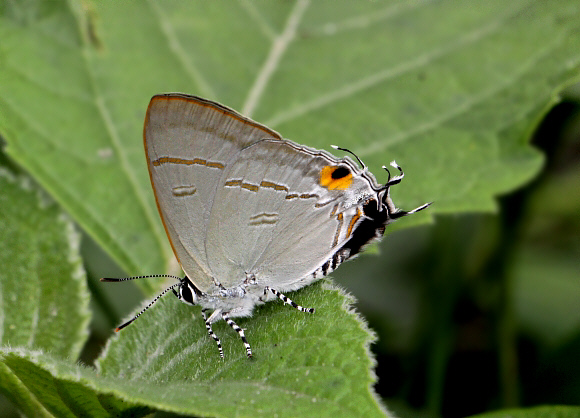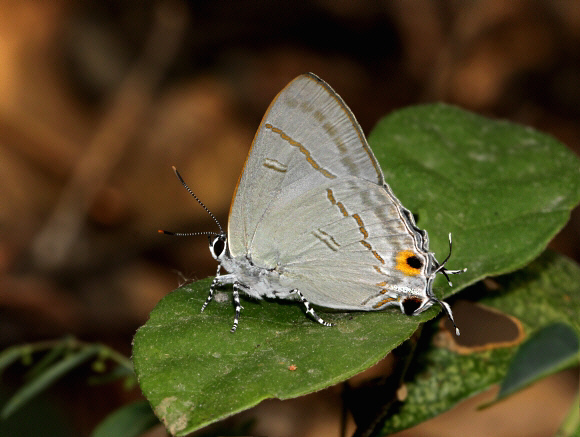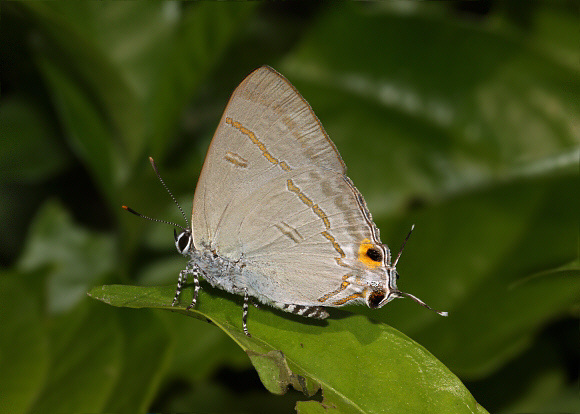
Introduction
There are 45 Hypolycaena species, 22 of which are found in the Afrotropical region, 1 in China, and 18 in south-east Asia including 4 which occur in West Malaysia. In the Australian region a further 4 are found, but they differ in several ways from other Hypolycaena species. Oriental Hypolycaena species are commonly known as Tits.
The upperside of the male of erylus is dark brown but reflects a deep metallic purple sheen under certain lighting conditions. It has a narrow black border, and on the forewings there is a large black patch of androconial scales. The female lacks the purple sheen, and has a series of broken white markings and black tornal spots on the hindwings. The tails are present in both sexes.
Hypolycaena erylus is a common and widespread species, found in India, Myanmar, Thailand, Laos, Cambodia, peninsular Malaysia, Sumatra, Borneo, Sulawesi and Papua New Guinea.

Habitats
This species occurs in many habitats including coastal mangrove, lowland rainforest and temperate hill forest, at elevations between sea level and about 1200 metres.

Lifecycle
The eggs are laid on Meyna pubescens, Vangueria spinosa (Rubiaceae), Cinnamomum zeylanicum (Lauraceae), and probably on other plants.
After hatching and eating their egg shells the tiny larvae are abducted by weaver ants Oecophylla smaragdina. The same species of ant also captures larvae of Anthene emolus. The ants carry their captives into their nests, which are constructed by weaving leaves together. Oecophylla are large and extremely aggressive ants, but they make no attempt to attack the larvae, which probably placate their captors either by using a chemical deterrent, or by means of an ‘appeasement song’. Research on various other Lycaenids has shown that their larvae and pupae are able to stridulate, producing an audible ‘chirp’ that can deter ants from attacking.
The larvae feed within the ant nests on leaves, and possibly also on substances regurgitated by the ants. Studies have demonstrated that 1st instar larvae are unable to survive outside the ant nests and will not feed on leaves outside the nest. This may be due to the warm and humid microclimate within the ant nest, or it could be the case that a substance produced by the ants softens the leaves and makes it easier for the larvae to digest them. After the larvae moult to the 2nd instar, the ants then remove them from their nests, and carefully transport them to young sprigs of the foodplant some distance away.
A few days later when the larvae reach their 3rd instar they develop honey-producing glands on their backs, and thereafter are constantly attended by the ants, which “milk” them to drink the sugary secretion. The relationship is not truly symbiotic, because while the larvae cannot survive without the ants, the ants are able to obtain their ‘honey’ from other sources.
The chrysalis is smooth, plump, rounded and pale green in colour.
Adult behaviour
Males can commonly be found imbibing mineralised moisture from sand, rocks, road surfaces or the walls of buildings in forested areas. Both sexes nectar at various wild and cultivated flowers.
The adults always hold their wings erect when feeding. They periodically oscillate their hindwings, causing the little ‘false antennae’ tails to wiggle. This, in combination with the ‘false eye’ marking at the edge of the wings, gives the impression of a back-to-front butterfly, and diverts the attention of predators away from the butterfly’s head and body. Birds generally try to predict which direction a butterfly will take, so they aim their attack at a point just ahead of the butterfly. Hypolycaena erylus and other Theclinae turn this to their advantage, tricking the bird into aiming behind the butterfly, which then flies forward and often escapes unharmed.
When not feeding, both sexes sit on foliage, often high up on bushes or on the lower branches of trees, but they also sometimes settle on low herbage and bask with their wings fully outspread.

